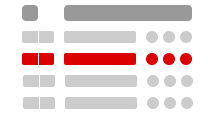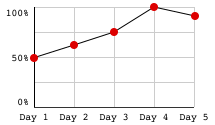Free to Join!
Easily See Your Progress
 We track the progress you've made on a topic so you know what you've done. From the course view you can easily see what topics have what and the progress you've made on them. Fill the rings to completely master that section or mouse over the icon to see more details.
We track the progress you've made on a topic so you know what you've done. From the course view you can easily see what topics have what and the progress you've made on them. Fill the rings to completely master that section or mouse over the icon to see more details.Make Use of Our Learning Aids
Earn Achievements as You Learn
 Make the most of your time as you use StudyPug to help you achieve your goals. Earn fun little badges the more you watch, practice, and use our service.
Make the most of your time as you use StudyPug to help you achieve your goals. Earn fun little badges the more you watch, practice, and use our service.Create and Customize Your Avatar
 Play with our fun little avatar builder to create and customize your own avatar on StudyPug. Choose your face, eye colour, hair colour and style, and background. Unlock more options the more you use StudyPug.
Play with our fun little avatar builder to create and customize your own avatar on StudyPug. Choose your face, eye colour, hair colour and style, and background. Unlock more options the more you use StudyPug.
Introduction to Dividing Decimals
Dividing decimals is a crucial mathematical skill that builds upon your previous knowledge of multiplying decimals. This section introduces you to the concept and techniques of decimal division, which are essential for solving complex mathematical problems. To begin, we recommend watching our introduction video, which provides a clear and concise explanation of the process. This visual guide will help you grasp the fundamental principles and steps involved in dividing decimals. The video serves as an important foundation for understanding the concept, making it easier to follow the subsequent lessons and practice exercises. By mastering the art of dividing decimals, you'll enhance your overall mathematical proficiency and problem-solving abilities. Remember, just as with multiplying decimals, precision and attention to decimal point placement are key factors in achieving accurate results when dividing decimals.
In this guide, we will divide the decimal number 3.4 by 2 using diagrams. This method helps visualize the division process and understand the concept better.
Step 1: Represent the Number 3.4 Using Diagrams
First, we need to represent the number 3.4 using diagrams. We can break down 3.4 into 3 ones and 4 tenths.
We use large tiles to represent the ones and smaller tiles to represent the tenths. So, we have:
- 3 large tiles, each representing 1 (totaling 3 ones)
- 4 smaller tiles, each representing 0.1 (totaling 0.4 tenths)
Step 2: Divide the Ones into Two Groups
Next, we need to divide the 3 ones into two equal groups. Since 3 is an odd number, we can only evenly distribute 2 of the ones, leaving 1 one left over.
So, each group will have:
- 1 large tile (representing 1)
And we have 1 large tile left over.
Step 3: Convert the Remaining One into Tenths
To divide the remaining 1 one, we convert it into tenths. Since 1 one is equal to 10 tenths, we now have:
- 10 tenths from the remaining one
- 4 tenths from the original 0.4
This gives us a total of 14 tenths.
Step 4: Divide the Tenths into Two Groups
Now, we need to divide the 14 tenths into two equal groups. Dividing 14 by 2 gives us 7 tenths in each group.
So, each group will have:
- 7 smaller tiles (representing 0.7)
Step 5: Combine the Ones and Tenths in Each Group
Finally, we combine the ones and tenths in each group. Each group has:
- 1 large tile (representing 1)
- 7 smaller tiles (representing 0.7)
So, each group represents the number 1.7.
Conclusion
By dividing the number 3.4 into two groups using diagrams, we can see that each group represents the number 1.7. Therefore, 3.4 divided by 2 equals 1.7.
-
What is the decimal shift method in division?
The decimal shift method is a technique used to simplify decimal division problems. It involves multiplying both the dividend and divisor by the same power of 10 to eliminate decimal places, converting the problem into whole number division. This method makes the calculation easier without changing the actual value of the quotient.
-
How do you identify if a decimal will be terminating or repeating?
To identify if a decimal will be terminating or repeating, look at the denominator of the fraction. If the denominator can be expressed as a product of only 2 and 5 (prime factors of 10), the decimal will terminate. If the denominator contains any other prime factors, the decimal will repeat. For example, 1/8 (8 = 2³) will terminate, while 1/3 will repeat.
-
What are common mistakes to avoid when dividing decimals?
Common mistakes in decimal division include misplacing the decimal point, forgetting to add zeros to continue division, ignoring trailing zeros, struggling with divisors less than 1, and making rounding errors. To avoid these, always double-check decimal point placement, use estimation to verify reasonableness, and pay attention to the required level of precision.
-
How do you handle division when the divisor is less than 1?
When the divisor is less than 1, the quotient will be larger than the dividend. To handle this, you can use the decimal shift method to convert the divisor to a whole number. For example, to divide 1.8 by 0.3, multiply both numbers by 10 to get 18 ÷ 3, which is easier to calculate.
-
Why is mastering decimal division important?
Mastering decimal division is crucial for various real-life applications such as budgeting, cooking, and data analysis. It enhances numerical fluency, improves problem-solving skills, and provides a foundation for more advanced mathematical concepts. Proficiency in decimal division also helps in everyday calculations and decision-making processes involving fractions and percentages.
Understanding the process of dividing decimals requires a solid foundation in several key mathematical concepts. One of the most crucial prerequisites is multiplying decimals. This skill is essential because division is often viewed as the inverse operation of multiplication, and many division strategies involve multiplying by reciprocals.
Another fundamental concept is place value, which is critical in division of decimals. Knowing the significance of each digit's position helps in aligning decimal points correctly and understanding how to shift the decimal point when necessary. This understanding is closely tied to the negative exponent rule, which comes into play when dealing with very small decimal numbers or when converting between decimal and scientific notation.
Proficiency in adding and subtracting decimals is also crucial, as these operations are often part of the division process, especially in long division or when checking results. Additionally, the ability to convert repeating decimals to fractions can be helpful in simplifying and interpreting division results.
Understanding greatest common factors (GCF) and least common multiples can aid in simplifying division problems and finding equivalent fractions, which is often useful in decimal division. This concept extends to more advanced topics like polynomial long division, where similar principles are applied to algebraic expressions.
As students progress, they'll find that the skills learned in dividing decimals are foundational for solving problems with rational numbers in decimal form. This ability is crucial in various real-world applications and more advanced mathematical concepts.
Even seemingly unrelated topics like the rational zero theorem build upon the understanding of division and rational numbers, showcasing how fundamental decimal division is to higher-level mathematics.
By mastering these prerequisite topics, students will find themselves well-equipped to tackle the challenges of dividing decimals. Each concept provides a crucial piece of the puzzle, allowing for a deeper understanding and more efficient problem-solving in decimal division and beyond. Remember, mathematics is a cumulative subject, and a strong grasp of these foundational concepts will pave the way for success in more advanced mathematical endeavors.



